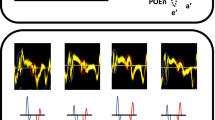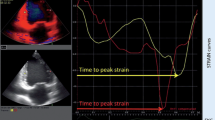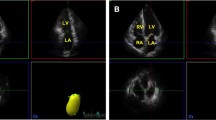Summary.
Background and Introduction:
Cardiac resynchronization therapy (CRT) is a promising non-pharmacological treatment option for patients (pts) with severe severe heart failure (CHF), systolic left ventricular (LV) dysfunction, and ventricular conduction abnormalities (VCA). Pt selection for CRT, however, is still controversial. Tissue Doppler echocardiography (TDE) can be used to analyze regional wall motion with high temporal resolution.
Patients and methods:
In 33 CHF pts with VCA (QRS width ≥140 ms) and 20 normal probands, left and right ventricular (RV) filling and emptying were analyzed by flow and tissue Doppler to assess regional (anterior, lateral, inferior, and septal) asynchrony within the LV as well as asynchrony between the RVand LV. All time measurements were corrected for a heart rate of 60 bpm. Results Maximum interventricular and segmental intraventricular delay was 30 ms in the normals. LV asynchrony, defined as a regional delay of ≥40 ms, was found in 29/33 (88%) of the CHF pts, in 4 cases there was synchronous LV contraction despite VCA. In the pts with LV asynchrony, 22 (67%) showed the maximum delay in the lateral wall, 7 (21%) in the septum. Inter- and intra-ventricular asynchrony correlated weakly.
Conclusions:
In many CHF pts with VCA, there is a delay both between the two ventricles, and among different LV regions. Predominantly but not exclusively, the LV lateral wall shows the maximum intra-LV delay. Some CHF pts, however, seem to have a synchronous LV contraction despite VCA. TDE thus adds important information for pt selection with respect to CRT.
Zusammenfassung.
Hintergrund und Einleitung:
Die kardiale Resynchronisationstherapie (CRT) ist eine vielversprechende nichtmedikamentöse Therapieoption für Patienten (Pat.) mit schwerer Herzinsuffizienz (CHF), systolischer linksventrikulärer (LV-)Pumpfunktionsstörung und gestörter Erregungsausbreitung (EAS). Die Präzision der Patientenselektion für die CRT ist jedoch noch nicht befriedigend. Mittels Gewebe-Dopplerechokardiographie (TDE) ist die regionale Analyse des LV-Kontraktionsablaufs mit hoher zeitlicher Auflösung möglich.
Patienten und Methodik:
Wir überprüfen bei 33 CHF-Pat. mit EAS (Breite des QRS-Komplexes ≥140 ms) und 20 Normalpersonen Parameter der rechts-(RV-) und linksventrikulären Füllung und Entleerung mittels Fluss- und Gewebe-Doppler mit dem Ziel, eine mechanische Asynchronie innerhalb des LV (anteriore, laterale, inferiore und septale Region) bzw. eine interventrikuläre (RV-LV-)Asynchronie zu charakterisieren. Alle Zeitmessungen wurden auf eine Frequenz von 60/min korrigiert. Ergebnisse Die maximale inter- bzw. intraventrikuläre Asynchronie betrug bei den Normalpersonen 30 ms. Eine LV-Asynchronie, definiert als eine regionale Verzögerung um ≥40 ms, fand sich bei 29/33 (88%) der CHF-Pat., in 4 Fällen kontrahierte der LV jedoch trotz EAS synchron. Bei den Pat. mit LV-Asynchronie wies in 22 Fällen (67%) die laterale Wand, in 7 Fällen (21%) das Septum die maximale Verzögerung auf. Zwischen inter- und intraventrikulärer Asynchronie bestand nur eine schwache Korrelation.
Schlussfolgerung:
Bei CHF-Pat. mit EAS besteht vielfach eine zeitliche Latenz sowohl zwischen LV- und RVAuswurf als auch zwischen verschiedenen LV-Regionen. Vorwiegend, aber nicht ausschließlich betrifft die maximale Kontraktionsverzögerung die laterale Wand. Einige CHF-Pat. zeigen trotz EAS eine mechanisch synchrone Kontraktion. Die TDE kann somit wertvolle Informationen zur Selektion von CHF-Pat. liefern, die von der CRT profitieren könnten.
Similar content being viewed by others
Author information
Authors and Affiliations
Corresponding author
Additional information
Teile dieser Untersuchungen wurden als Abstract anlässlich der 67. Jahrestagung der Deutschen Gesellschaft für Kardiologie—Herz- und Kreislaufforschung, Mannheim, 19.–21. April 2001, sowie der 5. Jahrestagung der „Working Group on Echocardiography“ der European Society of Cardiology—Euro-Echo 5, Nizza, 5.–8. 12. 2001, vorgestellt
Rights and permissions
About this article
Cite this article
Faber, L., Lamp, B., Hering, D. et al. Analyse der inter- und intraventrikulären Asynchronie mittels Fluss- und Gewebe-Dopplerechokardiographie. Z Kardiol 92, 994–1002 (2003). https://doi.org/10.1007/s00392-003-1006-4
Received:
Accepted:
Issue Date:
DOI: https://doi.org/10.1007/s00392-003-1006-4
Key words
- Heart failure
- left ventricular dysfunction
- bundle branch block
- tissue Doppler echocardiography
- cardiac resynchronization therapy




